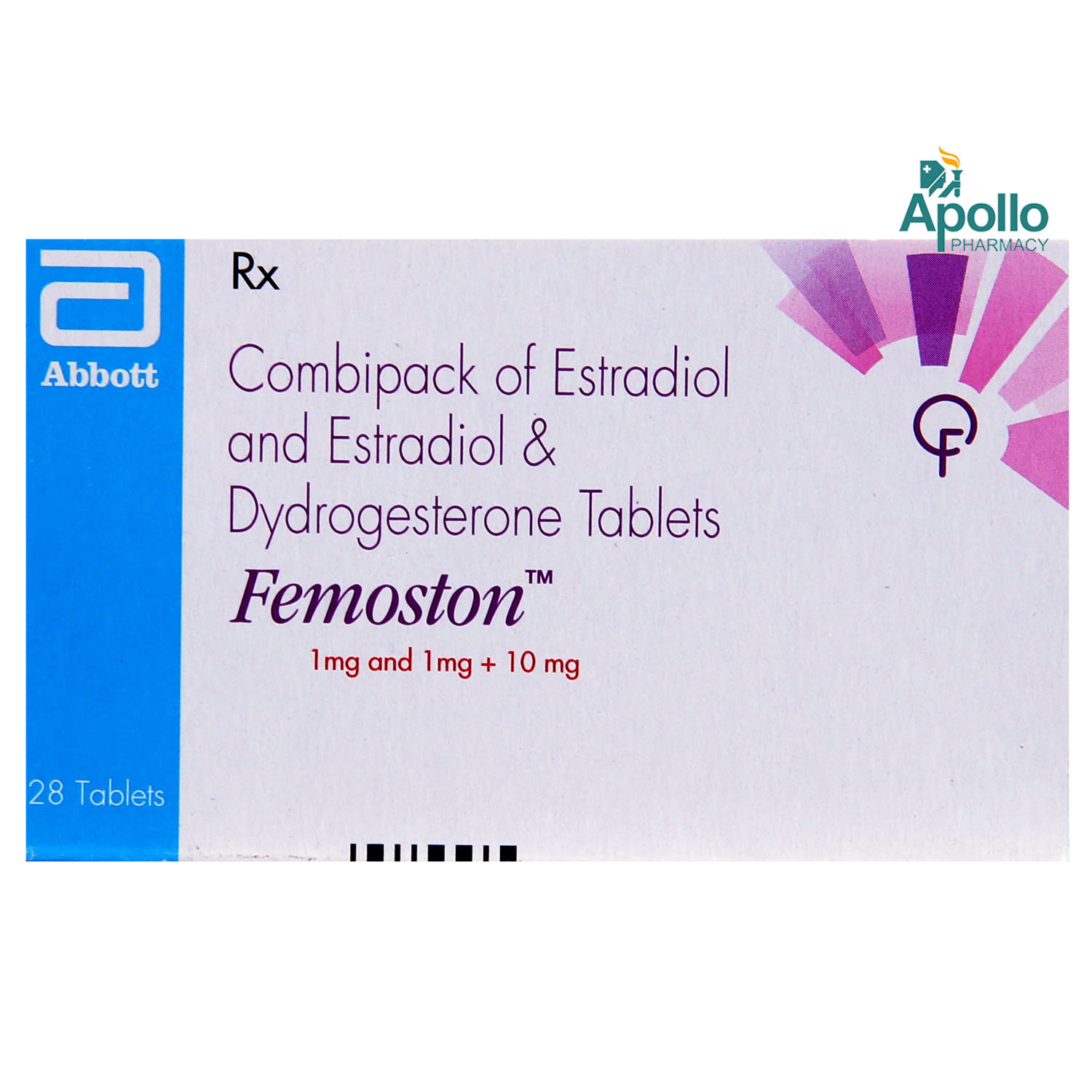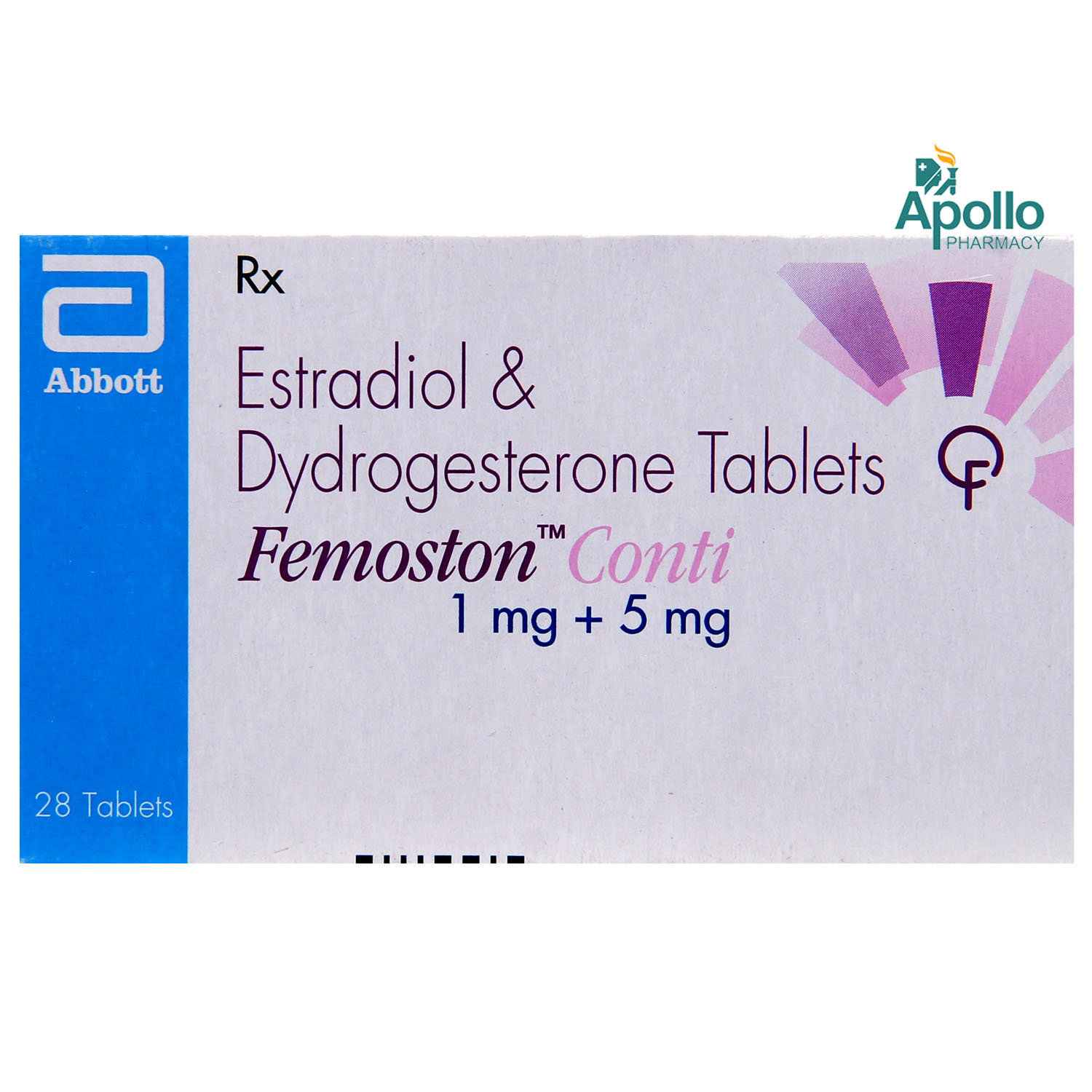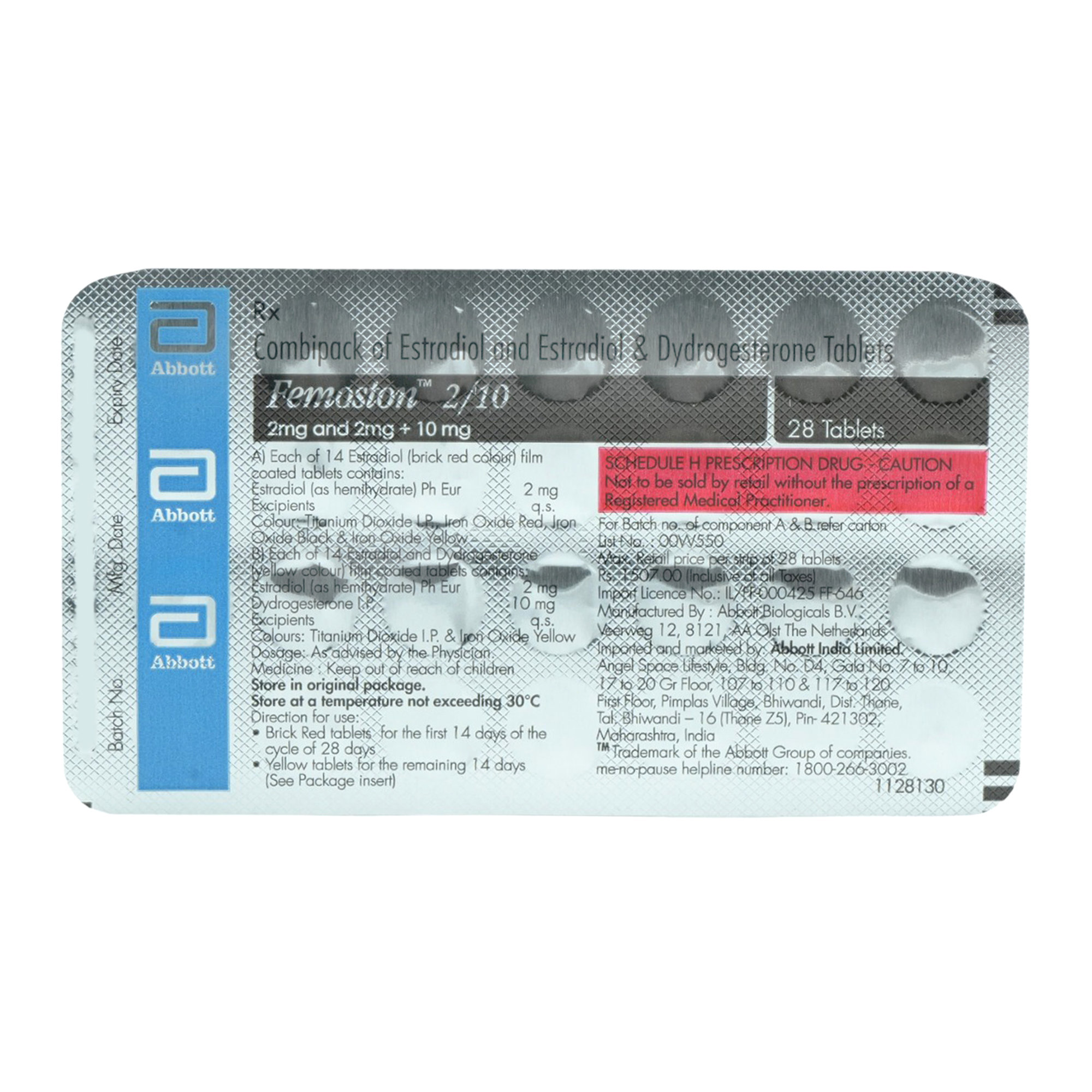Dydrogesterone+estradiol
About Dydrogesterone+estradiol
Dydrogesterone+estradiol is a hormone replacement therapy (HRT) used to treat postmenopausal symptoms and prevent osteoporosis (weak and brittle bones) caused by menopause in women. Post-menopause is a condition in which women have not had a period for 12 months or more. During menopause, estrogen levels decrease, leading to hot flushes (feeling of heat over the face, neck, and chest). Women with menopause are at risk of developing osteoporosis (thinning of bones). Dydrogesterone+estradiol can be used to prevent osteoporosis after menopause. Osteoporosis is a bone disease that weakens and thins bones by decreasing bone density which is common in post-menopausal women.
Dydrogesterone+estradiol contains two female hormones, Estradiol and Dydrogesterone. Estradiol works by replacing the falling levels of estrogen in the body and thus helps to reduce menopause symptoms. Dydrogesterone works by reducing the overgrowth of the womb lining. Together, Dydrogesterone+estradiol helps treat postmenopausal symptoms and osteoporosis.
Dydrogesterone+estradiol should be taken as advised by your doctor. The dose of medicine and duration of treatment will be decided by the doctor based on your medical condition. Dydrogesterone+estradiol may cause certain side effects such as stomach pain, headache, breast pain or tenderness and back pain. Most of these side effects do not require medical attention and gradually resolve over time. However, if these side effects persist or worsen, please consult your doctor.
Dydrogesterone+estradiol should be avoided if you are allergic to it or if you have a history of breast cancer, endometrial cancer (cancer of the lining of the womb), unexplained vaginal bleeding, untreated endometrial hyperplasia (thickening of the womb lining), blood clotting disorder, heart attack or angina (chest pain), inherited porphyria (a blood disorder) or liver disease. It is not recommended for use in pregnant and breastfeeding women. Stop taking Dydrogesterone+estradiol and consult your doctor immediately if you develop jaundice (yellowing of the skin and eyes), high blood pressure and migraine-like headache, become pregnant or notice signs of a blood clot such as redness, swelling and pain in the legs, sudden chest pain or difficulty in breathing. Inform your doctor if you have any intolerance to sugar.
Uses of Dydrogesterone+estradiol
Medicinal Benefits
Dydrogesterone+estradiol contains Estradiol and Dydrogesterone used to treat postmenopausal symptoms and prevent osteoporosis (weak and brittle bones) caused by menopause in women. Estradiol restores the falling levels of estrogen in the body and thus helps to reduce menopause symptoms. Dydrogesterone decreases the overgrowth of the womb lining. Also, Dydrogesterone+estradiol is used as prophylaxis in preventing osteoporosis in postmenopausal women and prevents bone loss and fractures.
Directions for Use
Storage
Side Effects of Dydrogesterone+estradiol
- Stomach pain
- Headache
- Breast pain or tenderness
- Back pain
- Changes in your menstrual periods
- Nausea
Drug Warnings
Before starting treatment with Dydrogesterone+estradiol, inform your doctor if you are allergic to it. Avoid taking Dydrogesterone+estradiol if you are pregnant or breastfeeding. Dydrogesterone+estradiol is not recommended for children. If you have premature menopause, inform your doctor before taking Dydrogesterone+estradiol so that the risks and benefits may be compared. Avoid taking Dydrogesterone+estradiol if you have recently had a stroke, heart attack or angina (chest pain), liver disease and untreated endometrial hyperplasia (thickening of the womb lining). If you have very high levels of fat (triglycerides) in your blood, inform your doctor before taking Dydrogesterone+estradiol. You are recommended to avoid alcohol consumption with Dydrogesterone+estradiol as it may increase the risk of breast cancer. If you experience sudden chest pain, difficulty breathing, or painful swelling and redness of your legs, stop taking Dydrogesterone+estradiol and consult a doctor immediately, as these might be signs of a blood clot. Long-term use and high dosages of this medication may raise your risk of heart attack, stroke, blood clots, breast cancer, or uterine cancer. Hence discuss this risk with your doctor before taking Dydrogesterone+estradiol.
Drug Interactions
Drug-Drug Interactions: Dydrogesterone+estradiol may interact with anticonvulsants (phenytoin, carbamazepine, phenobarbital), antitubercular drugs (rifabutin, rifampicin), anti-HIV drugs (efavirenz, nelfinavir, ritonavir, nevirapine), painkiller (fentanyl), bronchodilator (theophylline) and immunosuppressants (cyclosporine, tacrolimus).
Drug-Food Interactions: Dydrogesterone+estradiol may interact with St. John’s wort (herbal medicine to treat depression). Also, avoid alcohol consumption, as it can lead to undesirable side effects.
Drug-Disease Interactions: If you have high blood pressure, gallstones, diabetes, migraine, epilepsy (fits), asthma, fluid retention due to kidney or heart problems, unexplained vaginal bleeding, breast cancer, liver disease, estrogen-sensitive cancer, porphyria, fibroids in the womb, endometrial hyperplasia (excessive thickening of the womb lining), blood clotting disorder or blood clot in the vein, inform your doctor before taking Dydrogesterone+estradiol.
Drug-Drug Interactions Checker List:
Safety Advice

Alcohol
unsafeAvoid consumption of alcohol with Dydrogesterone+estradiol as it may increase the risk of breast cancer and delay healing.

Pregnancy
unsafeDydrogesterone+estradiol is only recommended for postmenopausal women. Therefore, consult a doctor if you are pregnant.

Breast Feeding
unsafeIt is not recommended for use in breastfeeding. Hence, inform your doctor before taking Dydrogesterone+estradiol if you are breastfeeding. Your doctor may suggest you stop feeding while on treatment with this medicine.

Driving
not applicableDydrogesterone+estradiol may not affect your ability to drive.

Liver
unsafeDydrogesterone+estradiol should not be used in patients with liver diseases. Inform your doctor if you have/had a history of liver disease before starting treatment with this medicine.

Kidney
cautionDydrogesterone+estradiol should be used with caution in patients with severe kidney diseases. Hence, if you have a pre-existing or a history of kidney disease, inform your doctor before taking Dydrogesterone+estradiol. Your doctor may adjust the dose or prescribe a suitable alternative based on your condition.

Children
unsafeDydrogesterone+estradiol is recommended for use in post-menopause women.
Habit Forming
Diet & Lifestyle Advise
- Wear loose, layered clothing during the nighttime, especially in warm weather. This prevents hot flushes.
- Manage your weight. Shed excess weight by exercising regularly if you are obese or overweight.
- Talk to a psychologist if you feel low, sad, isolated, or have sleeping issues.
- Limit alcohol intake and quit smoking.
-
Try to eat foods that are rich in iron and Vitamin C, including red meat, shellfish, eggs, beans, and leafy green vegetables.
Special Advise
- Regular breast screening is recommended while taking Dydrogesterone+estradiol.
- Check your breasts regularly for any changes in the nipple, dimpling of the skin or any lumps.
- While giving blood for tests, inform your doctor that you are taking Dydrogesterone+estradiol as this medicine may affect some test results.
Patients Concern
Disease/Condition Glossary
Post menopause: Menopause occurs when a woman is between 45 and 55 and has not had a period for 12 months or more. Post-menopause is a condition in which women have not had a period for 12 months or longer. The oestrogen levels decrease in postmenopausal women resulting in symptoms such as hot flushes (hot neck, face and chest).
Osteoporosis: It is a bone disease that weakens and thins bones by decreasing bone density. As the density of bones decreases, they weaken and are more likely to break. Post-menopausal women are more likely to develop osteoporosis than men because, at menopause, a woman’s ovaries stop the production of oestrogen (a female hormone), which is essential to keep bones healthy. Following menopause, bone loss occurs, making bones weak and more likely to break. Signs and symptoms include back pain caused by a fractured or collapsed vertebra, loss of height over time, a stooped posture, and a bone that breaks much more easily than expected.
FAQs
Dydrogesterone+estradiol contains two female hormones, Estradiol and Dydrogesterone. Estradiol works by replacing the falling levels of estrogen in the body and thus helps to reduce menopause symptoms. Dydrogesterone works by reducing the overgrowth of the womb lining. Also, Dydrogesterone+estradiol is used as prophylaxis in preventing postmenopausal osteoporosis.
Dydrogesterone+estradiol is not a contraceptive. Dydrogesterone+estradiol is a hormone replacement therapy. Therefore, if you are less than 50 years old or if it is less than 12 months since your last period, you are advised to use additional contraceptive measures to avoid pregnancy. However, discuss with a doctor if you have any concerns regarding this.
Dydrogesterone+estradiol may cause irregular bleeding or spotting (drops of blood) during the first 3 to 6 months of taking Dydrogesterone+estradiol. However, if the bleeding or spotting continues for more than six months or after discontinuing Dydrogesterone+estradiol, please consult a doctor immediately.





